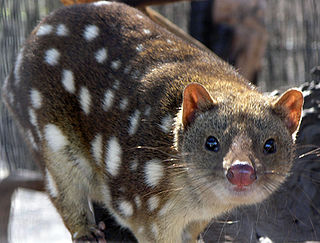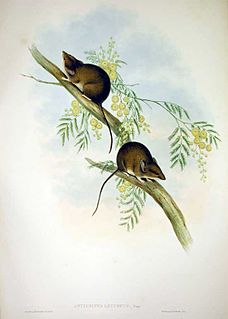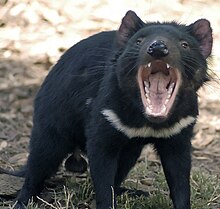
A wallaby is a small or middle-sized macropod native to Australia and New Guinea, with introduced populations in New Zealand, Hawaii, the United Kingdom and other countries. They belong to the same taxonomic family as kangaroos and sometimes the same genus, but kangaroos are specifically categorised into the four largest species of the family. The term "wallaby" is an informal designation generally used for any macropod that is smaller than a kangaroo or a wallaroo that has not been designated otherwise.

Dasyuromorphia is an order comprising most of the Australian carnivorous marsupials, including quolls, dunnarts, the numbat, the Tasmanian devil, and the thylacine. In Australia, the exceptions include the omnivorous bandicoots and the marsupial moles. Numerous South American species of marsupials are also carnivorous, as were some extinct members of the order Diprotodontia, including extinct kangaroos and thylacoleonids, and some members of the partially extinct clade Metatheria and all members of the extinct superorder Sparassodonta.

The Dasyuridae are a family of marsupials native to Australia and New Guinea, including 69 extant species divided into 21 genera. Many are small and mouse-like or shrew-like, giving some of them the name marsupial mice or marsupial shrews, but the group also includes the cat-sized quolls, as well as the Tasmanian devil. They are found in a wide range of habitats, including grassland, underground, forests, and mountains, and some species are arboreal or semiaquatic. The Dasyuridae are often called the 'marsupial carnivores', as most members of the family are insectivores.

Threatened fauna of Australia are those species and subspecies of birds, fish, frogs, insects, mammals, molluscs, crustaceans and reptiles to be found in Australia that are in danger of becoming extinct. This list is the list proclaimed under the Australian federal Environment Protection and Biodiversity Conservation Act 1999. The classifications are based on those used by the World Conservation Union (IUCN), however IUCN and Australian rankings do differ. Each state and territory has its own legislation relating to environmental protection.

The subfamily Sminthopsinae includes several genera of small, carnivorous marsupials native to Australia: kultarrs, ningauis, dunnarts, and planigales.

Macropodinae is a subfamily of marsupials in the family Macropodidae, which includes the kangaroos, wallabies, and related species. The subfamily includes about ten genera and at least 51 species. It includes all living members of the Macropodidae except for the banded hare-wallaby, the only surviving member of the subfamily Lagostrophinae.
Wadderin Sanctuary is a nature conservation project within the Shire of Narembeen in the eastern wheatbelt of Western Australia. It is about 290 km east of Perth and 8 kilometres north of the town of Narembeen. Wadderin is surrounded by a fox- and cat-proof fence that was completed in early 2008. This has allowed the reintroduction of fauna that is uncommon or locally extinct in the wheatbelt, and includes species that are considered threatened at the national level.
Riversleigh fauna is the collective term for any species of animal identified in fossil sites located in the Riversleigh World Heritage Area.










